What is a hydrofoil?
In fluid mechanics, a foil is a solid 3D object (shaped like a wing or fin) that is moved in a fluid to create lift.
The most familiar type of foil is an airplane wing, called an aerofoil. Its distinctive shape and cross-section allows an airplane to generate lift in the air. In this case, the fluid is a gas.
When the fluid is a liquid, such as water, the foil is termed a hydrofoil.
Hydrofoils are commonly applied to watercrafts such as boats, yachts, kayaks, and even surfboards to reduce drag and increase speed (by lifting their hulls out of the water).
A boat using hydrofoil technology is simply known as a hydrofoil.
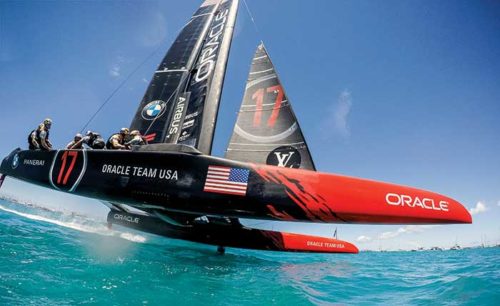
History and development of hydrofoils
The first hydrofoil is attributed to a British patent granted to Emmanuel Denis Farcot in 1869. It featured a system of inclined planes and wedges to lift the vessel out of the water. In 1898, Enrico Forlanini obtained patents to develop his “ladder” foil system.
In 1909, British boatmaker John Thornycroft designed a 22-foot long boat with a stepped hull and single bow foil. It rode on a flat stern and was able to achieve 40 mph while powered by a 60 horsepower engine.
Around the same time, Comte de Lambert designed a hydrofoil with variable pitch fins attached to twin hulls beneath the water. It was able to skim over the surface of the water on its fins and looked like an airplane.
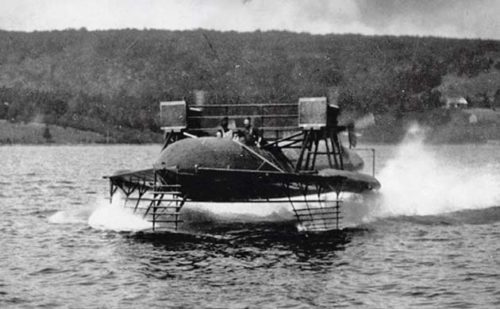
By this time, Alexander Graham Bell considered hydrofoils and hydroplanes (a distinct type of boat that also relied on lift forces) to be a significant achievement, so he met with leading hydrofoil designers to collaborate on new designs. In 1919, his HD-4 research watercraft set a world speed record of 71 mph with the aid of two 350 horsepower engines from the U.S. Navy.
The first jet-powered hydrofoil was created by a pair of English designers in the early 1950’s, but it failed to beat the record set by Bell’s 1919 HD-4.
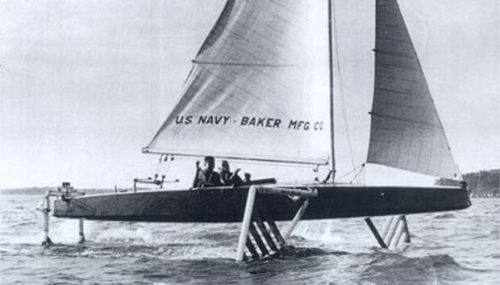
The first commercial hydrofoil, the PT10 “Golden Arrow” (developed by Supramar), was launched in 1952 and was able to transport 32 passengers at 40 mph. Design improvements continued through 1971.
In 1961, the first commuter hydrofoils in the U.S. were commissioned by Harry Gale Nye, Jr.
How does a hydrofoil work?
A hydrofoil works by deflecting the flow of water to create higher pressure on the bottom of the foil (i.e., the lifting force) and reduced pressure on the top. The pressure and velocity difference of the water flowing around the foil is generated by the structure’s winglike shape and angle of attack.

The hydrofoil structure is attached on struts below a vessel’s hull or across its keels. As the boat moves faster, the hydrofoil elements generate sufficient lift to raise the hull above the surface of the water.
This in turn increases the vessel’s speed and fuel efficiency because turbulence and drag forces are reduced on the hull’s surface. If the foil is placed at the optimum angle of attack, lift can be held constant while the drag force is minimized.

Hydrofoil configurations
There are numerous hydrofoil design shapes that resemble the letters of the alphabet. Each provides varying degrees of single or multi directional lift. A few of the most common include the:
- L-foil
- V-foil
- T-foil
Used mainly in sailing craft, the L-foil configuration has one horizontal hydrofoil attached to the bottom of a vertical keel (i.e., centerboard) to form the shape of an ‘L’. It continues to generate upward lift as the sailing craft increases speed to the point where the entire keel and hydrofoil may break the surface and cause a sudden loss of lift. Despite this instability, the L-foil generates less drag than other designs.
The V-foil is similar to the L-foil except that the hydrofoil is attached to the shaft at an upward angle (less than 90 degrees). Lift is gradually reduced as the V-foil starts to penetrate the surface near the bottom angle, allowing the weight of the boat to push it down towards a balanced height above the water. Therefore, the V-foil is considered a self-stabilizing design that is relatively easy to control. However, the disadvantage of this design is that it creates more drag and less lift than the L-foil.
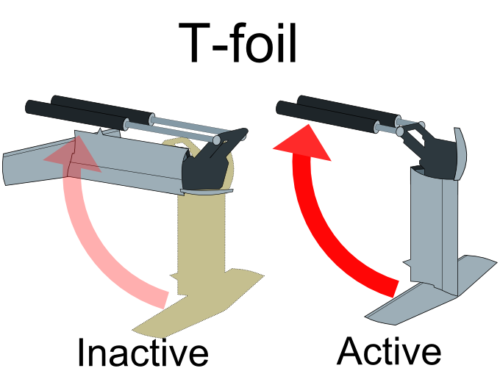
The T-foil is a fully submerged design (shaped like an inverted ‘T’) that is less vulnerable to wave turbulence and helps provide a more stable and comfortable ride for passengers. However, the T-foils are not self-stabilizing and their angle of attack must be controlled by sensor-controlled flaps to maintain a smooth ride as conditions change (e.g., water level).
Advantages of hydrofoils
The primary advantage of hydrofoils is to reduce drag by lifting the hull above the surface of the water.
This can be a major benefit, depending on the watercraft, since drag reduction results in higher cruising speeds, greater fuel efficiency, and more comfort for passengers (i.e, less wave action).
That being said, some drag force is necessary for maneuverability and agility, so hydrofoils are not designed to completely eliminate it.
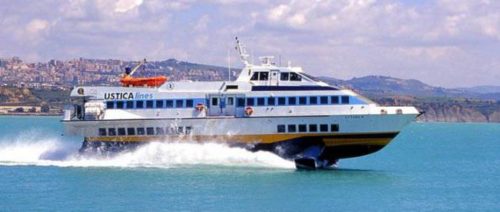
Disadvantages of hydrofoils
However, hydrofoils are known to have several disadvantages leading to their decreased commercial application in recent times:
- Hydrofoils are expensive to build and maintain, making them less economical than conventional vessels for commercial applications such as transportation (although they are still deployed as passenger transport vessels in many areas around the world).
- Hydrofoils are more susceptible to impacts with marine animals or floating objects, and can potentially break apart.
- Hydrofoils have sharp edges that can injure marine animals and even people in some circumstances.
- Fixed or rigid hydrofoil configurations are only good for moving forward and lack maneuverability.
